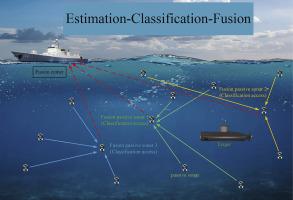Underwater passive sonar fusion detection based on sensor bias estimation and classification
IF 3
3区 工程技术
Q2 ENGINEERING, ELECTRICAL & ELECTRONIC
引用次数: 0
Abstract
Passive sonar is crucial for underwater target detection but often experiences reduced localization accuracy due to sensor biases and positional deviations caused by environmental factors. Traditional approaches struggle to effectively address these biases and also lack an integrated analysis of bias estimation, sensor classification, and fusion algorithms. To address this issue, this paper proposes a bias estimation-classification-fusion localization (BECFL) algorithm, integrating bias estimation, sensor classification, and adaptive fusion weighting. Within the BECFL framework, dynamic stochastic models are first developed to characterize underwater target motion, sensor biases, and multipath fading channels. Sensor biases are then estimated using maximum likelihood estimation (MLE) based on multiple sensor observations. Sensors are subsequently classified through an improved expectation-maximization (EM) algorithm, iteratively refining the classification parameters. A variable step-size weighting fusion approach is applied, reducing the impact of sensor biases on localization results. Simulations demonstrate that, compared to existing methods, the BECFL algorithm improves localization accuracy and maintains robust performance even under significant sensor bias, data loss, false alarms, and missed detections. Additionally, analyses of actual underwater data confirm the practical applicability of the proposed algorithm for passive sonar detection and localization in underwater environments.

基于传感器偏差估计与分类的水下被动声呐融合检测
被动声呐是水下目标探测的关键,但由于环境因素造成的传感器偏差和位置偏差,往往会导致定位精度降低。传统的方法难以有效地解决这些偏差,也缺乏对偏差估计、传感器分类和融合算法的综合分析。为了解决这一问题,本文提出了一种偏差估计-分类-融合定位(BECFL)算法,该算法将偏差估计、传感器分类和自适应融合加权相结合。在BECFL框架内,首先开发了动态随机模型来表征水下目标运动、传感器偏差和多径衰落信道。然后使用基于多个传感器观测值的最大似然估计(MLE)估计传感器偏差。随后,通过改进的期望最大化(EM)算法对传感器进行分类,迭代地改进分类参数。采用变步长加权融合方法,减小了传感器偏差对定位结果的影响。仿真结果表明,与现有方法相比,BECFL算法提高了定位精度,即使在严重的传感器偏差、数据丢失、误报和漏检情况下也能保持鲁棒性。此外,通过对水下实际数据的分析,验证了该算法在水下环境中被动声呐探测与定位的实用性。
本文章由计算机程序翻译,如有差异,请以英文原文为准。
求助全文
约1分钟内获得全文
求助全文
来源期刊

Digital Signal Processing
工程技术-工程:电子与电气
CiteScore
5.30
自引率
17.20%
发文量
435
审稿时长
66 days
期刊介绍:
Digital Signal Processing: A Review Journal is one of the oldest and most established journals in the field of signal processing yet it aims to be the most innovative. The Journal invites top quality research articles at the frontiers of research in all aspects of signal processing. Our objective is to provide a platform for the publication of ground-breaking research in signal processing with both academic and industrial appeal.
The journal has a special emphasis on statistical signal processing methodology such as Bayesian signal processing, and encourages articles on emerging applications of signal processing such as:
• big data• machine learning• internet of things• information security• systems biology and computational biology,• financial time series analysis,• autonomous vehicles,• quantum computing,• neuromorphic engineering,• human-computer interaction and intelligent user interfaces,• environmental signal processing,• geophysical signal processing including seismic signal processing,• chemioinformatics and bioinformatics,• audio, visual and performance arts,• disaster management and prevention,• renewable energy,
 求助内容:
求助内容: 应助结果提醒方式:
应助结果提醒方式:


